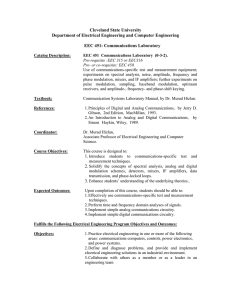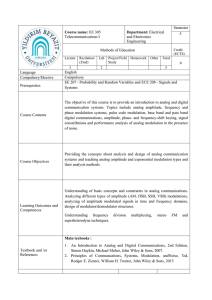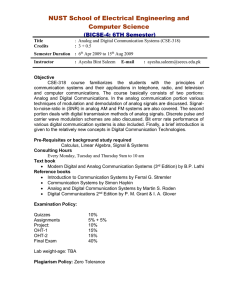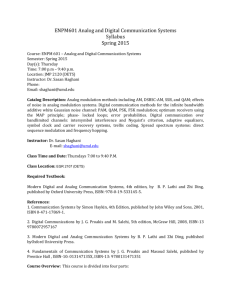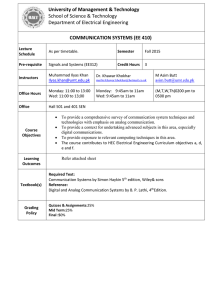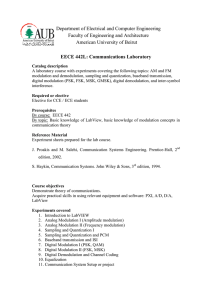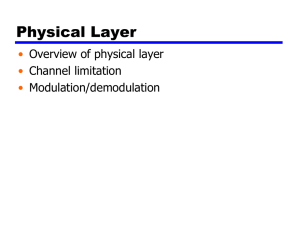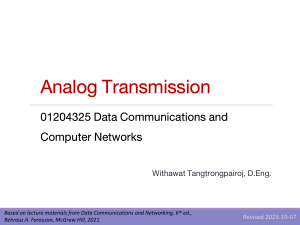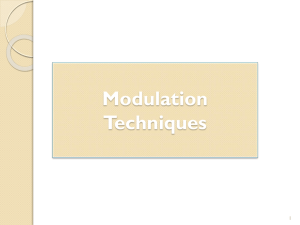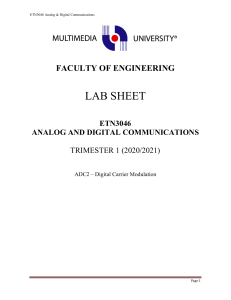EE460 - Department of Electrical and Computer Engineering
advertisement
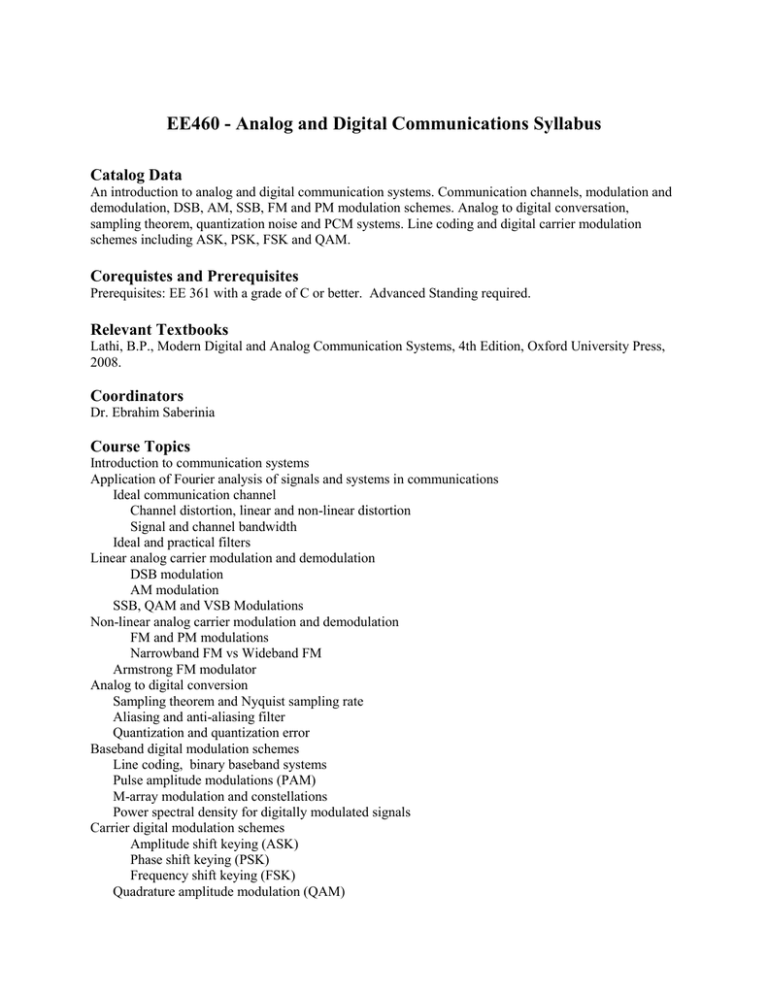
EE460 - Analog and Digital Communications Syllabus Catalog Data An introduction to analog and digital communication systems. Communication channels, modulation and demodulation, DSB, AM, SSB, FM and PM modulation schemes. Analog to digital conversation, sampling theorem, quantization noise and PCM systems. Line coding and digital carrier modulation schemes including ASK, PSK, FSK and QAM. Corequistes and Prerequisites Prerequisites: EE 361 with a grade of C or better. Advanced Standing required. Relevant Textbooks Lathi, B.P., Modern Digital and Analog Communication Systems, 4th Edition, Oxford University Press, 2008. Coordinators Dr. Ebrahim Saberinia Course Topics Introduction to communication systems Application of Fourier analysis of signals and systems in communications Ideal communication channel Channel distortion, linear and non-linear distortion Signal and channel bandwidth Ideal and practical filters Linear analog carrier modulation and demodulation DSB modulation AM modulation SSB, QAM and VSB Modulations Non-linear analog carrier modulation and demodulation FM and PM modulations Narrowband FM vs Wideband FM Armstrong FM modulator Analog to digital conversion Sampling theorem and Nyquist sampling rate Aliasing and anti-aliasing filter Quantization and quantization error Baseband digital modulation schemes Line coding, binary baseband systems Pulse amplitude modulations (PAM) M-array modulation and constellations Power spectral density for digitally modulated signals Carrier digital modulation schemes Amplitude shift keying (ASK) Phase shift keying (PSK) Frequency shift keying (FSK) Quadrature amplitude modulation (QAM) Course Outcomes (Program Outcomes) [UULOs] Upon completion of this course, students will be able to: 1. apply Fourier analysis to communication signals. (1.1, 1.2, 1.6,1.7,1.8,1.10) [2.3, 2.4, 2.5, 2.6] 2. explain how channel imperfections distort signals. (1.1, 1.2, 1.6,1.7,1.8,1.10) [2.4, 2.6] 3. derive the energy or power spectral density of signals(1.1, 1.2, 1.6,1.7,1.8,1.10) [2.4, 2.6] 4. design simple systems for generating and demodulating amplitude modulated signals (1.1, 1.2, 1.6,1.7,1.8,1.10) [2.4, 2.6] 5. design basic systems for the indirect and direct generation of FM signals (1.1, 1.2, 1.6,1.7,1.8,1.10) [2.4, 2.6] 6. determine the Nyquist sampling rate of a given signal (1.1, 1.2, 1.6,1.7,1.8,1.10) [2.4, 2.6] 7. determine the number of levels in a quantizer given signal-to-noise ratio and maximum input voltage (1.1, 1.2, 1.6,1.7,1.8,1.10) [2.4, 2.6] 8. describe the different types of line codes (1.1, 1.2, 1.6,1.7,1.8,1.10) [2.4, 2.6] 9. describe ASK, PSK, FSK and QAM digital modulation schemes (1.1, 1.2, 1.6,1.7,1.8,1.10) [2.4, 2.6] Program Outcomes The appropriate technical knowledge and skills An ability to apply mathematics through differential and integral calculus, An ability to apply advanced mathematics such as differential equations, linear algebra, complex variables, and discrete mathematics, An ability to apply knowledge of basic sciences, An ability to apply knowledge of computer science An ability to apply knowledge of probability and statistics, An ability to apply knowledge of engineering An ability to design a system, component, or process to meet desired needs within realistic constraints An ability to identify, formulate, and solve engineering problems An ability to analyze and design complex electrical and electronic devices An ability to use the techniques, skills, and modern engineering tools necessary for engineering practice. An ability to design and conduct experiments, as well as to analyze and interpret data University Undergraduate Learning Outcomes (UULOs) Inquiry and Critical Thinking Identify problems, articulate questions or hypotheses, and determine the need for information. Access and collect the needed information from appropriate primary and secondary sources. Use quantitative and qualitative methods, including the ability to recognize assumptions, draw inferences, make deductions, and interpret information to analyze problems in context, and then draw conclusions. Recognize the complexity of problems, and identify different perspectives from which problems and questions can be viewed. Evaluate and report on conclusions, including discussing the basis for and strength of findings, and identify areas where further inquiry is needed. Identify, analyze, and evaluate reasoning, and construct and defend reasonable arguments and explanations. Computer Usage Students use computational software (such as Matlab) to model and analyze simple communication systems. Instruction of computational software and its application to signals and linear systems takes place in EE 360D. Grading Homework Assignments, Computational Software Assignments, Quizzes, Mid-term Exams, Final Exam. Course Syllabus Preparer and Date Ebrahim Saberinia, Tuesday, January 20, 2015
